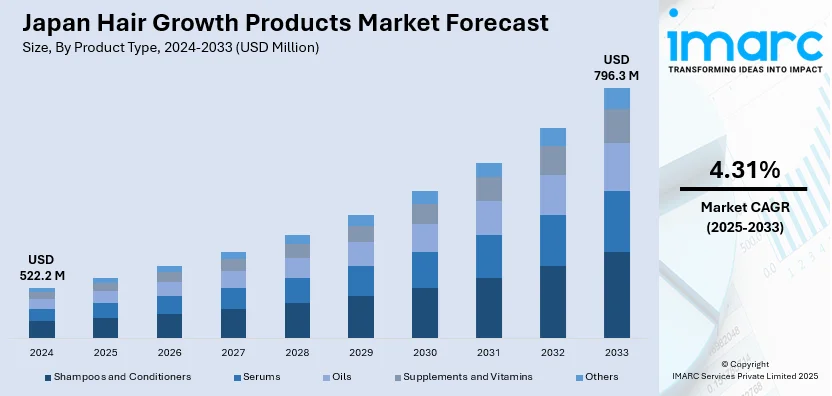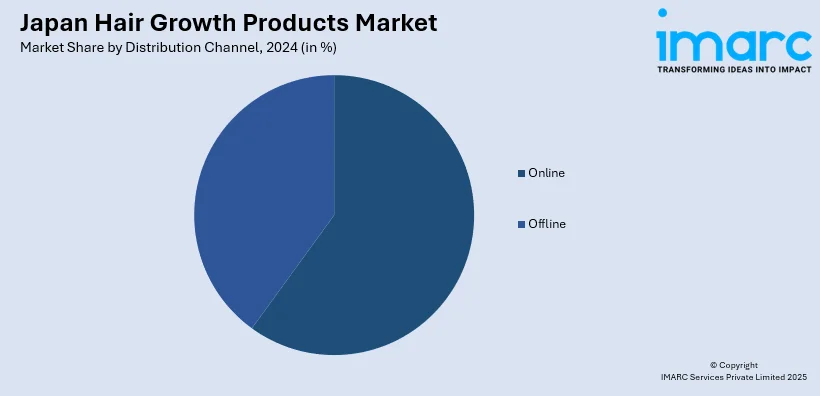
Japan Hair Growth Products Market Size, Share, Trends and Forecast by Product Type, Gender, Age Group, Distribution Channel, and Region, 2025-2033
Japan Hair Growth Products Market Overview:
The Japan hair growth products market size reached USD 522.2 Million in 2024. Looking forward, IMARC Group expects the market to reach USD 796.3 Million by 2033, exhibiting a growth rate (CAGR) of 4.31% during 2025-2033. The rising hair loss concerns, aging population, increased beauty consciousness, expanding male grooming segment, and growing demand for natural, clinically approved products continual product innovation, aggressive marketing strategies, and online retail expansion, are some of the key factors augmenting the Japan hair growth products market share.
|
Report Attribute
|
Key Statistics
|
|---|---|
|
Base Year
|
2024 |
|
Forecast Years
|
2025-2033
|
|
Historical Years
|
2019-2024
|
| Market Size in 2024 | USD 522.2 Million |
| Market Forecast in 2033 | USD 796.3 Million |
| Market Growth Rate 2025-2033 | 4.31% |
Japan Hair Growth Products Market Trends:
Increased Demand for Scalp-Focused and Clinically Validated Formulations
The growing consumer preference for scalp-focused and clinically backed formulations is positively impacting the Japan hair growth products market outlook. According to an industry report, approximately 1.45% to 2.18% of the Japanese population is affected by alopecia areata. This rising prevalence, combined with growing consumer awareness about the essential role of scalp health in managing hair loss and encouraging hair regrowth, is significantly influencing purchasing behavior. As a result, products that target specific scalp conditions, such as excess sebum production, inflammation, poor microcirculation, and follicular stress, are gaining traction, particularly those incorporating active pharmaceutical ingredients like minoxidil, adenosine, and hinokitiol. Additionally, botanical extracts supported by empirical evidence are preferred over traditional cosmetic ingredients. Also, dermatologist-endorsed solutions, often aligned with clinical research and safety assessments, emerge as a credible segment, reflecting consumer demand for proven efficacy. The presence of hybrid offerings at the intersection of cosmetics and pharmaceuticals, particularly from domestic cosmeceutical brands and healthcare companies, is contributing to this trend. Apart from this, marketing strategies that highlight clinical validation, medical-grade standards, and minimal side effects are proving highly effective, especially among middle-aged and aging populations concerned about early-stage hair thinning and scalp sensitivity.

Expansion of Male-Oriented and Gender-Neutral Hair Growth Solutions
The increasing focus on male-specific and gender-neutral product categories is providing a boost to Japan hair growth products market growth. Historically dominated by female-oriented solutions, the market is rapidly expanding to accommodate the rising demand from male consumers who are increasingly concerned with hair thinning, receding hairlines, and androgenetic alopecia. The shift is supported by evolving societal attitudes toward male grooming, with increased acceptability and encouragement for self-care practices among men. In response, manufacturers are introducing male-targeted formulations containing ingredients such as caffeine, saw palmetto, and DHT inhibitors designed to address hormone-related hair loss. For example, on June 16, 2024, Kao Corporation announced the launch of Success RESIL, a premium men's hair care line inspired by the skinification trend, featuring a shampoo and conditioner formulated with plant-derived amino acids in silicone-free compositions. These products are designed to cleanse and nourish the hair, promoting a healthy, voluminous appearance by removing excess sebum and enveloping hair strands with an elastic coating for enhanced suppleness and elasticity. This initiative aligns with Kao's strategy to strengthen its presence in the men's hair care segment. The availability of such offerings through e-commerce, pharmacies, and convenience stores provides consumers with discretion and ease of access, which are critical for personal care categories. In line with this, transparency in ingredient sourcing and performance claims further enhances credibility and consumer trust in this expanding segment.
Japan Hair Growth Products Market Segmentation:
IMARC Group provides an analysis of the key trends in each segment of the market, along with forecasts at the country level for 2025-2033. Our report has categorized the market based on product type, gender, age group, and distribution channel.
Product Type Insights:
- Shampoos and Conditioners
- Serums
- Oils
- Supplements and Vitamins
- Others
The report has provided a detailed breakup and analysis of the market based on the product type. This includes shampoos and conditioners, serums, oils, supplements and vitamins, and others.
Gender Insights:
- Men
- Women
A detailed breakup and analysis of the market based on the gender have also been provided in the report. This includes men and women.
Age Group Insights:
- Under 35
- 35 to 50
- Above 50
The report has provided a detailed breakup and analysis of the market based on the age group. This includes under 35, 35 to 50, and above 50.
Distribution Channel Insights:

- Online
- Offline
A detailed breakup and analysis of the market based on the distribution channel have also been provided in the report. This includes online and offline.
Regional Insights:
- Kanto Region
- Kansai/Kinki Region
- Central/ Chubu Region
- Kyushu-Okinawa Region
- Tohoku Region
- Chugoku Region
- Hokkaido Region
- Shikoku Region
The report has also provided a comprehensive analysis of all the major regional markets, which include Kanto Region, Kansai/Kinki Region, Central/ Chubu Region, Kyushu-Okinawa Region, Tohoku Region, Chugoku Region, Hokkaido Region, and Shikoku Region.
Competitive Landscape:
The market research report has also provided a comprehensive analysis of the competitive landscape. Competitive analysis such as market structure, key player positioning, top winning strategies, competitive dashboard, and company evaluation quadrant has been covered in the report. Also, detailed profiles of all major companies have been provided.
Japan Hair Growth Products Market News:
- On March 7, 2025, Japanese brand RASIX introduced the rDDS Scalp Essence, a serum formulated with nicotinamide mononucleotide (NMN) and plant polyphenols aimed at addressing hair and scalp concerns associated with aging. Utilizing RASIX's proprietary nanotechnology delivery system, the serum ensures deep penetration of active ingredients to enhance scalp vitality, promote hair growth, and improve hair volume and elasticity. The product is available through the brand's official online store and select retail outlets.
- On April 2, 2025, Japanese hair care brand MEDULLA introduced the ME-Drip RESQUE SHAMPOO, a serum shampoo designed to address hair damage concerns and cater to the emerging "bath-cancelling community." This product features high-quality ingredients inspired by aesthetic medicine and skin care, eliminating the need for additional treatments and thereby appealing to individuals who prefer to minimize time spent on beauty routines. The shampoo is packaged in a drip bag-like pouch with an S-hook for convenient bathroom storage and ease of use.
Japan Hair Growth Products Market Report Coverage:
| Report Features | Details |
|---|---|
| Base Year of the Analysis | 2024 |
| Historical Period | 2019-2024 |
| Forecast Period | 2025-2033 |
| Units | Million USD |
| Scope of the Report | Exploration of Historical Trends and Market Outlook, Industry Catalysts and Challenges, Segment-Wise Historical and Future Market Assessment:
|
| Product Types Covered | Shampoos and Conditioners, Serums, Oils, Supplements and Vitamins, Others |
| Genders Covered | Men, Women |
| Age Groups Covered | Under 35, 35 to 50, Above 50 |
| Distribution Channels Covered | Online, Offline |
| Regions Covered | Kanto Region, Kansai/Kinki Region, Central/ Chubu Region, Kyushu-Okinawa Region, Tohoku Region, Chugoku Region, Hokkaido Region, Shikoku Region |
| Customization Scope | 10% Free Customization |
| Post-Sale Analyst Support | 10-12 Weeks |
| Delivery Format | PDF and Excel through Email (We can also provide the editable version of the report in PPT/Word format on special request) |
Key Questions Answered in This Report:
- How has the Japan hair growth products market performed so far and how will it perform in the coming years?
- What is the breakup of the Japan hair growth products market on the basis of product type?
- What is the breakup of the Japan hair growth products market on the basis of gender?
- What is the breakup of the Japan hair growth products market on the basis of age group?
- What is the breakup of the Japan hair growth products market on the basis of distribution channel?
- What is the breakup of the Japan hair growth products market on the basis of region?
- What are the various stages in the value chain of the Japan hair growth products market?
- What are the key driving factors and challenges in the Japan hair growth products market?
- What is the structure of the Japan hair growth products market and who are the key players?
- What is the degree of competition in the Japan hair growth products market?
Key Benefits for Stakeholders:
- IMARC’s industry report offers a comprehensive quantitative analysis of various market segments, historical and current market trends, market forecasts, and dynamics of the Japan hair growth products market from 2019-2033.
- The research report provides the latest information on the market drivers, challenges, and opportunities in the Japan hair growth products market.
- Porter's five forces analysis assist stakeholders in assessing the impact of new entrants, competitive rivalry, supplier power, buyer power, and the threat of substitution. It helps stakeholders to analyze the level of competition within the Japan hair growth products industry and its attractiveness.
- Competitive landscape allows stakeholders to understand their competitive environment and provides an insight into the current positions of key players in the market.
Need more help?
- Speak to our experienced analysts for insights on the current market scenarios.
- Include additional segments and countries to customize the report as per your requirement.
- Gain an unparalleled competitive advantage in your domain by understanding how to utilize the report and positively impacting your operations and revenue.
- For further assistance, please connect with our analysts.
 Request Customization
Request Customization
 Speak to an Analyst
Speak to an Analyst
 Request Brochure
Request Brochure
 Inquire Before Buying
Inquire Before Buying




.webp)




.webp)












